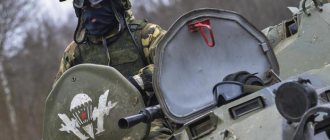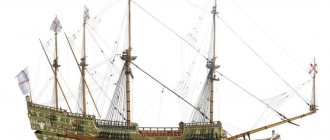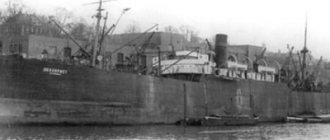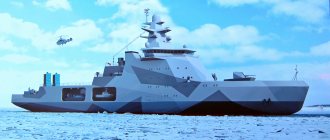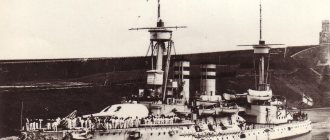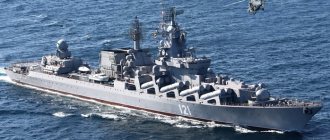The beginning of the new millennium became a kind of milestone in the history of the development of military fleets. The military-political situation in the world that changed after the collapse of the Soviet Union and the collapse of the “Soviet bloc” led to a change of course in the development of the naval forces of the leading states. Today, the navy is no longer seen only as one of the components that make up the nuclear deterrent force. The main focus is on the universalization of military fleets. Old ships capable of performing limited tactical missions are being replaced by new universal ships with greater technical capabilities and equipped with modern firepower.
Leader
New technologies are the most important element in the development of the navy
Technical progress entails the emergence of new technologies. Accordingly, there is a development of weapons, a change in military tactics and strategy. So it was, so it is and so it will always be. The navy has always been in the forefront in this regard, being the most advanced and technically advanced type of weapons. Gone are the days when one of the main components of the military power of the fleet was quantity. The era of sailing ships ended with the advent of the steam engine and armor. Sailing armadas were replaced by combat squadrons consisting of steel armored monsters. A warship has turned into a highly complex technical mechanism, where a mass of units and machines, devices and equipment are concentrated in a small and limited space.
Along with the improvement of the propulsion system, there was progress in weapons and protection. Initially, artillery was the basis of the striking power of a warship. The advent of rifled artillery and an increase in the caliber of artillery pieces inevitably entailed thickening of the armor. The larger the caliber of naval guns became, the thicker the armor belt was. The displacement of military vessels increased accordingly. The rivalry between armor and projectile continued until the middle of the 20th century. The artillery duel of the main forces of the fleet was the basis of linear tactics. The main task of the warring parties during military clashes was to inflict more damage on the enemy. With the appearance of mine and torpedo weapons on the scene, the emergence of aviation put an end to the dominant position of artillery in the fleet. Superiority at sea no longer depended on the number of battleships and cruisers. New combat ships and watercraft were required, specifically designed to perform certain combat missions at sea.
Submarines, minelayers and torpedo boats appear first. A little later, aircraft carriers enter the arena of naval battles. The torpedo and aircraft become the main means of warfare at sea. The navy is turning into a universal branch of the armed forces, capable of solving various combat tactical tasks and performing strategic functions. The Second World War made its own adjustments to the development of naval weapons, and the subsequent Cold War led to a change in the policy of using naval fleets. Battleships are history. Cruisers have lost their leading position in the fleet. The second half of the 20th century became the era of dominance of aircraft carriers and submarines. Missile weapons and aviation have practically ousted artillery from the fleet, relegating it to secondary roles. Following the guns, the armor faded into the background. The key to the high efficiency of the navy was the power of weapons, stealth, long range and technical equipment. Modern fleets have ceased to be a silent instrument for demonstrating power at sea, becoming an instrument for conducting foreign policy.
Operational TSH
The concept of the navy of the future - the presence of new and modern warships
In the current military-political situation, more and more countries are relying on strengthening their own naval forces. Even small countries with access to the sea are striving to acquire their own navies. The navy today is becoming perhaps the only means of preventing external aggression and ensuring the safety of maritime borders. In addition, new technologies today make it possible to build ships of moderate displacement, while equipping them with all available weapons, communications and detection equipment.
Missile boats
During the Cold War, new classes of warships emerged. Today, instead of torpedo boats, there are missile boats and a boat armed with anti-ship missiles. Small in size and displacement, such vessels are full-fledged combat units capable of competing on equal terms with larger vessels. Submarines were divided into two classes - strategic missile submarines and torpedo submarines with a nuclear or conventional propulsion system. Both of them have sufficient firepower, capable of not only wiping out entire cities from the face of the earth, but also delivering targeted strikes against the enemy anywhere in the world, both on land and at sea.
New classes of ships are replacing battleships and cruisers. Frigates and corvettes are being built abroad. Together with aircraft carriers and submarines, these ships form the basis of modern fleets of foreign countries. Along with strike forces, large landing craft - helicopter carriers - appear in the fleets, and special-purpose vessels are built and launched. If in the United States the main focus is on the aircraft carrier fleet, then in countries such as Great Britain, France, Japan and China, destroyers, frigates and corvettes become the main combat vessels. The Soviet Union, in an attempt to achieve military parity with the United States and the NATO bloc, is building Large Anti-Submarine Ships (BOD), Heavy Aircraft Carrier Cruisers (TAKR), and patrol ships for the needs of its Navy.
BOD
New military vessels are radically different from their predecessors in the range of weapons and tactical and technical characteristics. Now each individual warship is an independent combat unit of the fleet, which is capable of performing a huge amount of work. Eg:
- destroyers - ships capable of carrying out combat patrols in the far sea zone and attacking any enemy, both at sea and on land;
- frigates and corvettes are vessels responsible for guarding borders at close and distant approaches, conduct reconnaissance and patrol in their area of responsibility, and can attack any enemy on the surface, under water and on land;
- small missile ships are similar in functionality to corvettes, however, in some cases they are the striking force of the fleet;
- patrol ships are responsible for protecting maritime borders in nearby waters;
- landing dock ships are capable of delivering infantry personnel, military equipment and equipment to any corner of the globe, providing the amphibious landing zone with technical means and fire support;
- aircraft carriers are becoming universal, capable of carrying both airplanes and helicopters.
Aircraft carriers
The concept of fleet development indicates that military vessels must perform a wide range of tactical combat missions. There is a shift away from the concept of building large and expensive ships, giving preference to the construction of universal ships, smaller in size and displacement.
New generation ships for the Russian Navy
Russia, having become the successor to the USSR, inherited most of the warships of the Soviet Navy, once considered one of the most powerful in the world. Most of the ships were vessels built in the mid-70s and early 80s. These were modern and powerful ships for their time, built in series. Many warships were received in unfinished form, remaining in the shipyards of shipyards. The difficult economic situation in the country that developed in the 90s led to the fact that most of the sailing personnel of the Soviet navy lost their combat value. Some ships were simply obsolete and were dismantled for scrap. Other ships, launched quite recently, continued to remain in the Russian fleet, living out their days.
Rusting ship
In those years, the state was unable to maintain a huge military fleet in working and combat condition. In addition, the rapid development of technology that began in the late 90s led to the fact that the bulk of Soviet BODs, aircraft-carrying cruisers, cruisers, destroyers, minesweepers and the submarine fleet simultaneously became obsolete. In order to maintain its status as a maritime power, the Russian fleet urgently needed new powerful and powerful warships.
The start of a new stage in restoring the combat capability of the Russian fleet was the military shipbuilding program PVK 2050, adopted in the spring of 2014. The points and provisions of the program indicate the ways of development of the domestic navy, the approximate composition of the fleet, and determine the preliminary amount of costs for the development of projects and the construction of new ships. It is expected that a colossal amount, more than 8 billion rubles at the current exchange rate, will be spent to restore the former power of the domestic fleets, to bring them into line with the requirements of the time. This amount is calculated taking into account the fact that by 2050 the Russian fleet should be represented by 600 vessels of various classes, including strike forces and combat and technical support ships.
Table
The program provides the main parameters of the warship of the future for the Russian fleet. The emphasis is on introducing a completely new concept in shipbuilding. This takes into account the ship's new architecture, versatility and enormous power capacity. Most of the new projects of combat ships should be focused on the creation of unmanned detection and armed combat systems, where the human factor is excluded.
The Curse of the Big Fleet
A moderately toxic joke among military history buffs says: since the 19th century, it has become a custom that as soon as Russia plans to build an ocean-going “Big Fleet,” it immediately encounters major internal (or external) problems that prevent this fleet from being born.
The first attempt was launched in 1881 with a 20-year shipbuilding program, refined in 1895, the final expanded part of which, from 1898, was specifically labeled “for the needs of the Far East” because it was intended to strengthen the empire’s position in the Pacific. The results of this grandiose construction, almost in its entirety, except for the Black Sea ships, were sunk in the Port Arthur roadstead or sank to the bottom of the Tsushima Strait.
The second attempt was generated by the reckless planning of the military-political leadership of the USSR in the 30s. “Are we going to Mars in this five-year plan?” — the creators of the film “Taming of Fire” ironically played on such sentiments. The idea of serial construction of battleships and other heavy ships was cut short first by the reflexive repressions of the authors of the shipbuilding program at the first difficulties, and then by the Great Patriotic War, which for some time ended the Soviet country’s fascination with a large fleet.
Between these two approaches lay a competent attempt by Naval Minister Grigorovich to restore the fleet destroyed in Tsushima before the First World War. Relying on active officers of the Japanese war, many of whom had already reached high ranks by that time, and excellent shipbuilding specialists such as A.N. Krylov, I.G. Bubnov, V.P. Kostenko and others, the minister returned Russia to the number of maritime powers (as far as this was possible under those conditions). In the second half of the 1910s, shipbuilders were already drawing sketches of heavy artillery ships on drawing boards with an eye to construction after the Great War, but the two revolutions of 1917 and the Civil Revolution overturned these intentions.




